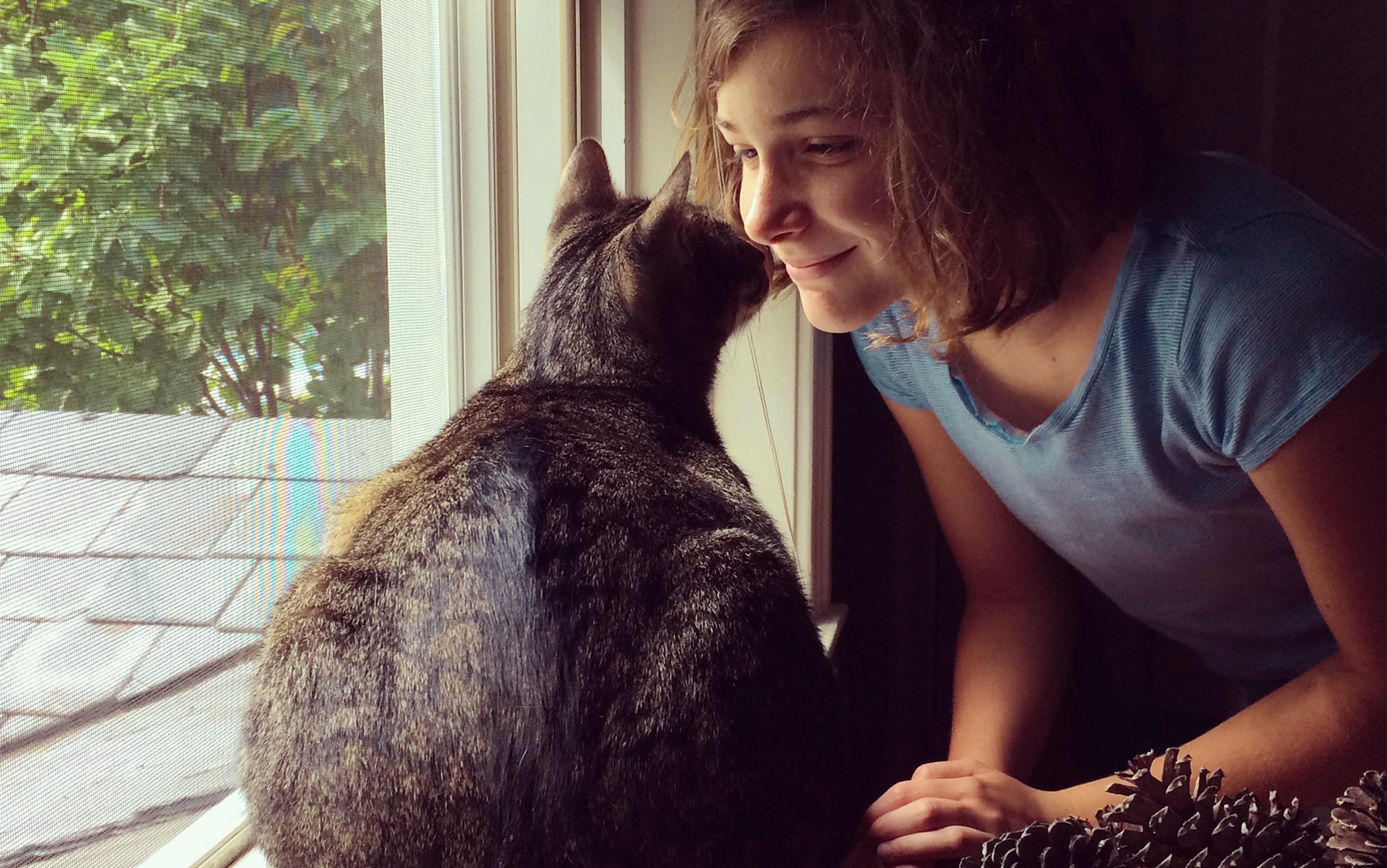Noam Sobel can’t stop watching you sniff your hands. In public, he sees people doing it everywhere. Here a man is leaning on one elbow, his palm covering his nose. Over there someone is playing with her upper lip, her fingers hovering just below her nostrils. Maybe you’re doing it right now.
Don’t be embarrassed. We humans are animals, and a growing body of research suggests that like other animals, we use our sense of smell to gather information about those around us. Sobel, a professor of neurobiology at the Weizmann Institute of Science in Israel, thinks sniffing our hands might be just one way that we sample each other’s odours so that we can learn from them.
Findings from other researchers suggest that a second language, spoken in scent, might be passing (as it were) right under our noses. Body odours are in the background of all our interactions. And the clues about relationships and emotions that we sniff out from these odours might be a crucial element of human society. The bodily smells of our fellow humans help us to recognise our relatives and friends and to bond with our babies. Even wearing a literal blindfold, we can recognise the musty aroma of an elderly person – an odour, by the way, that is not necessarily unpleasant. Meanwhile, the odour of illness can warn us to stay away from a contagious other.
Conventional wisdom holds that humans are not that gifted in the olfactory department. Watching our dogs and cats plant scent markings or sniff the air knowingly, we might feel as though our species is wearing a scent blindfold. Researchers trying to explain human sexual attraction and other interpersonal instincts couldn’t even find human pheromones – special molecules released by one individual and received by another of the same species, causing a specific reaction. Ants use pheromones to communicate and leave trails back to the home base. Boar pheromones, when sprayed into a pig sty, will make females that are in heat assume a mating stance. Yet, perhaps to our advantage in terms of conscious self-control, studies suggest that humans are happily immune. Sure, we can distinguish the smell of someone who has been drinking, or someone who ate garlic or curry recently – but a broad detection of such blatant or toxic odours seems a scant gift compared with species that can smell their way home.
Still, we do have a sense of smell, and surely it must be for more than just noticing that it’s time to take out the trash. That’s the thought that led Sobel to consider the olfactory significance of the handshake. It’s common in cultures around the world, if not quite universal. Historians might explain the origin of handshaking with a story describing how to show a stranger that you’re not holding a weapon. But Sobel wondered whether there could be a deeper motive, too – something more like a hearty butt-sniff between dogs.
To test the idea, Sobel and his colleagues brought subjects into a room and left them alone while secretly filming them. After a few minutes, an experimenter came in and greeted each subject, either with a handshake or not, then left the room for another few minutes. Even before the team analysed the experimental results, the videos were striking.
‘People are constantly sniffing their own hands,’ Sobel said. Sitting in a room alone, subjects spent 22 per cent of the time with one hand or the other near their nose. We might think of this behaviour as nervous grooming – scratching, biting a nail – but when the researchers measured air flow through the nose on another group of subjects, they showed that people with their hands near their noses were actively sniffing. The paper appeared in 2015 in eLife.
The point of all that sniffing wasn’t clear. After shaking hands with an experimenter of the same sex, subjects more than doubled their smelling of their shaking hand. If the experimenter was of the opposite sex, the researchers saw the same increased interest in the opposite hand, as if people were confirming their own smell. Sobel doesn’t think smell-swapping is the only reason for handshaking, or that handshaking is the only way we do it. But he thinks shaking hands might be part of how we chemically sample our world.
Another way might be through tears. In a 2011 paper in Science, Sobel had women watch sad movie clips and collect their tears in little vials. Male subjects couldn’t smell any difference between sad tears and ordinary saline that had been dribbled down the women’s cheeks. But after sniffing the tears, the men rated photos of other women as less attractive. Their testosterone levels also dropped. Sobel thinks the point of tears – whether a sad adult’s or a hungry infant’s – might be to carry a signal that reduces the others’ aggression. When we lean in for a hug, we get a good dose.
If our infectious neighbour suddenly smells a little grosser, we’ll keep our distance and avoid catching the same thing
Body odours, in fact, appear to serve as an early warning system for essential navigation of the world. Doctors have used patients’ odours for diagnosis, from the fresh-bread smell of typhoid fever to the musty smell of liver failure and the alleged grapey scent of a Pseudomonas infection. New research shows that even untrained humans can sniff out the difference between people who are healthy and those who are sick. To illustrate the point, Mats Olsson, Professor of Clinical Neuroscience at the Karolinska Institutet in Sweden, gave subjects squeeze-bottles to sniff and rate. Inside each bottle were the snipped-out armpit regions of a single T-shirt. Some of the shirts had been worn for several hours by a person whose immune system was artificially ramped up, as if he or she were just getting sick. Other shirts came from a normal, healthy person, and still others were worn by no one at all.
The bottle sniffers rated armpit swatches from immune-activated people as more intense, and less pleasant, than the swatches from healthy people. The people whose immune systems were activated hadn’t sweated any more than usual – rather, something seemed to be qualitatively different about their odours. ‘The exact nature of the cue or signal has yet to be determined,’ Olsson and his co‑authors wrote in a 2014 paper in Psychological Science.
It makes sense that humans might have evolved to sniff out a neighbour who’s getting sick, says Amy Gordon, a doctoral student in Olsson’s lab who also worked on this study. If our infectious neighbour suddenly smells a little grosser, maybe we’ll keep our distance and avoid catching the same thing.
The sense of smell might be most telling within the family group. Back in 1999, Richard Porter, a psychologist at Vanderbilt University in Tennessee, reported in Genetica that breastfed babies prefer the scent of their own mother’s breast to other mothers. They also prefer the odour of her armpit. Mothers, too, can recognise the smells of their babies’ heads, or T-shirts they’ve worn.
A possible explanation came from the animal kingdom, where many species recognise the scent of a relative as a way to avoid inbreeding. A highly variable set of genes called the major histocompatibility complex (MHC) helps to create body odours that animals can use to identify each other. Many studies have looked for a similar connection in humans between MHC types and how we choose our mates. In a 2009 review for Psychoneuroendocrinology, the anthropologist Jan Havlíček of Charles University in Prague and the evolutionary psychologist S Craig Roberts of the University of Liverpool concluded that most odour-based studies found that people preferred partners with different MHC types – a hint that we might use body odours to look for genetically dissimilar mates.
Fundamentally, we know how our basic sense of smell works: when someone stops to smell the roses, or sniffs at a questionable jug of milk, odour molecules travel up the nostrils and latch on to receptors. This sends a signal along neurons to the olfactory bulb, which sits on the underside of the brain just behind the bridge of the nose. From there, signals travel deeper into the brain, to areas collectively called the olfactory cortex.
Yet when you catch a waft of another person’s body, something else entirely might happen.
Johan Lundström, a neuroscientist at the Monell Chemical Senses Center in Philadelphia, is gathering evidence that a whiff of body odour activates a different processing network in your brain than other scents do. In a study published in Cerebral Cortex in 2008, Lundström scanned women’s brain activity while they breathed in body-odour smells. (Women are often the subjects of these studies because they tend to be more sensitive smellers.) The samples came from the women themselves, their very close friends, or strangers; researchers had sewn nursing pads into the armpits of T-shirts and had subjects wear them to bed for a week. There was also a fake body odour, made with cumin oil and anise oil.
Women could pick out both their own odours and their friends’ from the odours of strangers, though they didn’t feel confident about it. While they were breathing in these body odours, scans showed that the standard olfactory cortex regions weren’t lit up. Instead, Lundström saw a pattern of brain activation that included the posterior cingulate cortex, which responds to emotional stimuli, and the angular gyrus, which is involved in constructing an image of ourselves.
In a similar study published in 2009 in Human Brain Mapping, Lundström had women sniff samples from either their female friends or their own sisters. ‘Many subjects expressed frustration with the seemingly impossible task of identifying someone based on their body odour,’ the authors wrote, ‘although they unknowingly were able to perform the task with good accuracy.’ Again, the fake body odour lit up an expected olfactory centre, the orbitofrontal cortex. But the true body odours didn’t activate the olfactory cortex. When women sniffed their sisters’ odours, one of the active brain areas was the dorsomedial prefrontal cortex, which seems to help people recognise themselves.
Our body odours might even communicate emotions, such as fear or stress – and those emotions can be contagious. In a 2009 study in Psychological Science, the psychologists Wen Zhou and Denise Chen at Rice University in Texas collected sweat from men who were watching either horror movies or comedies. Women who then sniffed the horror-movie sweat were more likely to judge faces as fearful. In a 2009 study in the International Journal of Psychophysiology by the psychologist Bettina Pause at the University of Dusseldorf and others, students donated sweat while they were either exercising or awaiting a stressful oral exam. People who smelled the stress sweat startled more violently at loud noises, compared with people smelling the exercise sweat. Researchers at the University of Stony Brook in New York studied emotional contagion for a 2009 paper in PLOS ONE by taping sweat pads to the armpits of first-time skydivers on tandem jumps. (To ensure natural samples, the donors weren’t allowed to use deodorant. Pity their jumping partners.)
Emotional contagion is still a new field. It will take more research to confirm that these effects are real and repeatable – and to find out whether positive emotions can spread through smells along with negative ones. Richard Doty, who directs the Smell and Taste Center at the University of Pennsylvania, thinks that the whole idea of body odours carrying signals is unconvincing. He says learned association is a better explanation for the odour connection between mothers and babies. He also points out that brain-imaging studies, such as Lundström’s research into odour processing, can be unreliable.
Yet even if scientists disagree about the nature of body odours – are they molecular signals of mood, status and health, or meaningless scents that we’re adept at learning? – it seems clear that we haven’t given our noses enough credit.
Yet we also crave each other’s odours: the scent of a romantic partner, for example, lingering on a pillow
Even Sobel doesn’t think it would be a good thing if everyone suddenly saw themselves as members of a complex olfactory network, sampling and learning from others’ body odours. The rest of the world would become like him, constantly watching what people are touching and sniffing. Already, he says, in his lab, handshaking – once a mundane habit – has become something totally new. The researchers are hyperaware of what cues they might be exchanging with a simple greeting.
The rest of us might not be able to handle this awareness. It’s embarrassing to be caught smelling ourselves. Sobel saw evidence of this after his handshaking experiments, when researchers explained the purpose of the study to their subjects and asked for permission to publish their video footage. The people whose footage revealed the most extreme hand-sniffing behaviour refused to release it.
‘In our society generally, we do not appreciate body odours,’ said Johannes Frasnelli, an expert in chemosensory processing at Université du Québec à Trois-Rivières. ‘I’m no different – I don’t appreciate having somebody sweaty in front of me in the bus.’ A strong personal odour isn’t socially acceptable. We go to great lengths to cover up our human odours: we shower daily, launder our clothes, swipe on deodorant, spritz perfume, hang air fresheners in our cars. Whatever scent signals pass between our bodies have to fight their way through.
Yet we also crave each other’s odours. There’s the scent of a romantic partner, for example, which we might catch lingering on a pillow. ‘In the bedroom, the sense of smell becomes important,’ said Frasnelli. ‘Sometimes this can be scary because our culture prohibits us from enjoying the smell of somebody else.’
It’s perfectly acceptable, too, to take a hearty sniff of your baby. You can even sniff a friend’s baby, breathing in a little of that sweet, milky smell, without causing a fuss.
In these moments, our nature as olfactory animals comes through. When we inhale the scents of our loved ones, we might be reinforcing the bonds between us. Among strangers, whether we’re steeped in their aromas on the subway or greeting them with a handshake, we might be learning about people with our noses as much as with our eyes. Perhaps we should be okay, then, with breathing deeper to learn a little more.






